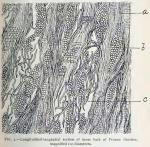Some Further Observations on Cherry Barks.
 Related entry: Structure of our Cherry Barks.
Related entry: Structure of our Cherry Barks.
Bark of the Western form of Prunus virginiana, Linné.
by Edson S. Bastin.
In Brewer and Watson's Flora of California this is treated as a distinct species, under the name of Prunus demissa, Walters; but Prof. C. S. Sargent regards it as only a form, not even a distinct variety, of the Choke cherry, Prunus Virginiana. It is somewhat less diffuse, and more tree-like in habit, though seldom attaining a height of more than 12 feet. Its leaves are pubescent underneath instead of smooth, their bases frequently somewhat cordate instead of wedge-shaped, their texture rather more leathery, and the fruits are usually less astringent than those of the Eastern form. Differences such as these, however, are certainly not specific, especially as the Eastern form is known to vary considerably in the shape, texture and hairiness of its leaves and in the color and astringency of its fruit. If Prof. Sargent's view be correct, the Choke cherry is, as he says, the most widely distributed of any American species of tree, for, to quote his language: "It grows within the Arctic Circle, ranging across the continent from Labrador and the shores of Hudson's Bay to the valley of the Mackenzie River, in latitude 62°, and crossing the Rocky Mountains, reaches the Pacific Coast in Northern British Columbia; it extends southward through Eastern North America to southern Georgia, Louisiana, Texas, northern Mexico and along the mountain ranges of Western North America.
"In the Eastern States it is one of the most common of the large tree-like shrubs, growing usually along the margins of the forest, generally in rich, rather humid soil, and along highways and fencerows; in southern Oregon and northern Cahfornia it inhabits low valleys, where, in rich, moist soil, in the neighborhood of streams, it attains a large and arborescent habit; on the mountain ranges of the interior of the continent, where it is confined to elevated valleys, in southern California, and at the northern and southern limits of its range, it is a low shrub." (The Silva of North America.)
 The specimens of bark examined by me were kindly supplied by Miss Alice Eastwood, of the California Academy of Sciences, and were obtained from Marin County, in that State.
The specimens of bark examined by me were kindly supplied by Miss Alice Eastwood, of the California Academy of Sciences, and were obtained from Marin County, in that State.
To the taste these specimens were less bitter, but quite as aromatic as good specimens of the bark of Prunus Serotina, excelling in the latter respect any specimens of P. Virginiana that the writer has before tested. This difference can easily be accounted for by differences in climatic conditions. No differences were observable between the bark of the Eastern and Western forms in the external markings, excepting the purely accidental one that the bark of older stems in the Western form was mostly covered with growths of crustaceous lichens, decking the surface with grayish and whitish patches and blackish dots and lines. The fracture and the color of the interior surface correspond closely with those of our Eastern form.
 Furthermore, a microscopic study does not reveal any considerable differences between the Western form and ours. The slight differences revealed by the drawings may well be due to the widely different conditions of growth. There are the wavy and oblique medullary rays that characterize all the species of the group; but, as in our Choke cherry, the rays are less oblique than in the other species thus far studied. The bast areas between the rays show wavy, compressed sieve-tissues, with walls in the older portions, irregularly thickened, and numerous long, slender, lignified bast fibres arranged irregularly, singly or in clusters. These fibres are frequently not straight, but wavy, particularly in the neighborhood of the medullary rays.
Furthermore, a microscopic study does not reveal any considerable differences between the Western form and ours. The slight differences revealed by the drawings may well be due to the widely different conditions of growth. There are the wavy and oblique medullary rays that characterize all the species of the group; but, as in our Choke cherry, the rays are less oblique than in the other species thus far studied. The bast areas between the rays show wavy, compressed sieve-tissues, with walls in the older portions, irregularly thickened, and numerous long, slender, lignified bast fibres arranged irregularly, singly or in clusters. These fibres are frequently not straight, but wavy, particularly in the neighborhood of the medullary rays.
Beyond the extremities of the medullary rays, in the cortex or middle bark, occur also numerous sclerenchyma fibres, a fact which was noted in my previous description of our Eastern form. These fibres are either clustered or single, and irregularly distributed. They are commonly wavy, and their position may be transverse or oblique, as well as lengthwise of the bark.
Stellate masses, as well as single crystals of calcium oxalate abound in all parenchymatous portions of the bark.
Starch in small quantities was also found in the parenchyma. As in other cherry barks, it is very small grained, but it differs from those in the others thus far studied, in the fact that the grains are mostly compound, the masses often consisting of a dozen or more granules. The hilum of the individual granule is usually quite distinct and is centrally located.
The fact that the Western and Eastern forms are not to be regarded as distinct species, or even as distinct varieties, does not preclude the possibility that the former may be richer in medicinal constituents. Indeed, its more aromatic taste and odor suggest that it is so, and that it might repay chemical investigation.
The American Journal of Pharmacy, Vol. 67, 1895, was edited by Henry Trimble.

